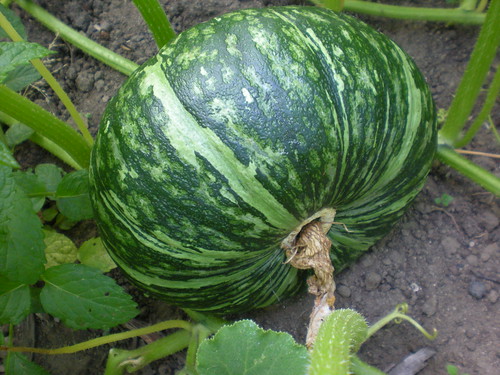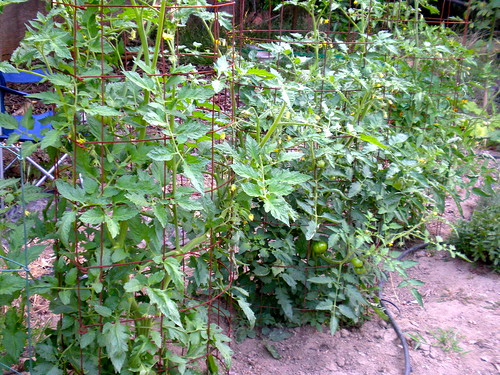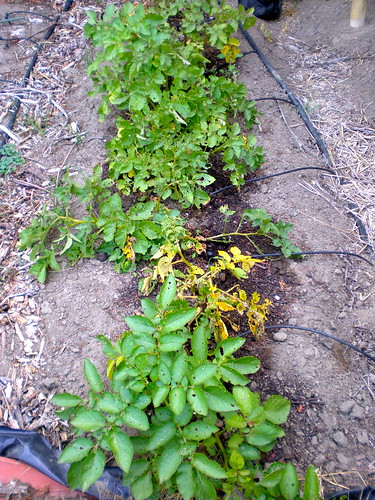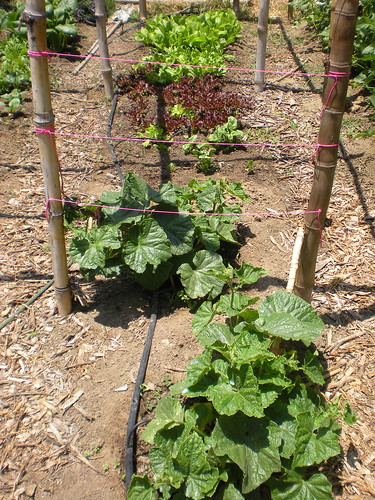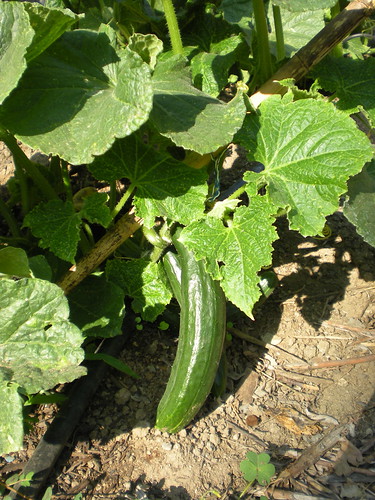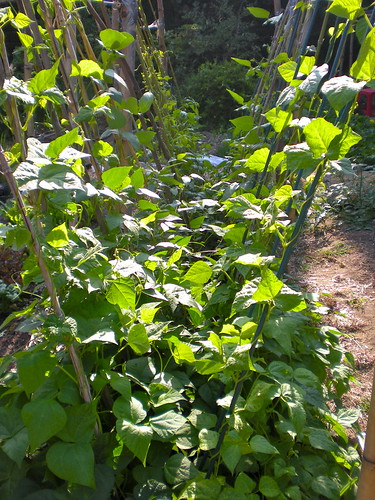We don't have too many pictures of veggies to show off this week. We had a couple groups of friends who came to visit the garden last week. We had fun walking around the garden. Everyone tried their hands in harvesting veggies and took home the harvests. And, of course I forgot to take pictures of those harvests.
I did take pictures of the harvest for Saturday night dinner. The cucumbers are slowing down. The tomatoes are ripping faster than we are picking. On Saturday and Sunday, we picked tomatoes both in the mornings and the afternoons.
This big fat carrot was one of the only two seeds that came up from my failed seed sowing in March. The other one I picked too early so there wasn't much of a carrot. Then I kept forgetting to pick this one. I chopped this one up and cooked it in soup. It was nice and sweet. This variety is Oxheart. They grow very short and fat, so they are good for heavy clay soils. We don't have heavy clay soils. I just like to grow different varieties for fun.
Although we don't have too many edibles to show off this week, we do have some non-edible harvest to share.
Here are some stargazer lilies we harvested for cut flowers.
I let some chive flowers go to seed so I can plant more next year, although I think there will be some volunteers next year. There were a lot seeds dropped to the ground. The seeds were kind of a pain to collect. It was hard to separate the dried up mini flowers from the seeds.
I have a monster celery plant going to seed. It's been there since last year. I harvested some of the seeds last Sunday. I can't wait for the rest of the seeds to dry up, so I can dig up the plant and grow something else there.
I had a much easier time collecting these seeds. I just used a fine sift to separate the debris from the seeds. I heard celery seeds can be used as seasoning for cooking. I'm going to give it a try. I guess you could count these as part of the edible harvest.
Showing posts with label tomato. Show all posts
Showing posts with label tomato. Show all posts
Monday, July 25, 2011
Wednesday, July 13, 2011
good news and bad news - tomato harvest and problems
The tomatoes are rolling in. These are my harvest from yesterday.
They are Beefsteak and Black Krim, or at least I think they are. The Beefsteaks are smaller than I thought they should be. The Black Krims are from a plant that I had labeled Green Zebra, but yesterday I found these dark red/purple tomatoes. I am not too sad about it. They are tasty.
I have one more plant labeled Green Zebra. I hope I got that one right. I do like Green Zebras.
We also got our first Sun Gold cherry tomatoes yesterday. They were sweet but not overly sweet, and they were really flavorful. They tasted more than just tomatoes. Two weren't enough to give a good description of these yummy fruits.
Now, for the bad news. The tomato plants are not short of problems this year, especially the three plants I transplanted out the earliest (you can see them here and here). It could be the cooky weather earlier this season, or it could be their location. They are shaded by the persimmon trees in the afternoon, so they get a bit less sunlight than the other tomato plants.
The leaves are showing signs of blight. It's unusual for me to get blight at this time of the year. It's not too terrible yet, and the stems and fruits are not affected. Since the temperature has kicked up a notch, I just cut off the infected leaves for now.
Tomato hornworms were never big problems for me and I never had to hand-pick them... until this season. I get really grossed out by worms, but they have done enough offense for me to get up the courage to look for and remove them. They chew up the leaves pretty badly, and they leave their "compliments to the gardener" on the leaves. I know worm poops are good in the soil. I don't know if they work the same on leaves.
***If you get offended by worms, stop reading here. If you are interested in seeing the offender in action, feel free to look at the next picture.***
They also ate some of the unripe fruits. They usually go for the smaller fruits, but I caught this one on a big Aunt Ruby's German Green that was just waiting to ripe. URGH!! That really gets me!
They are Beefsteak and Black Krim, or at least I think they are. The Beefsteaks are smaller than I thought they should be. The Black Krims are from a plant that I had labeled Green Zebra, but yesterday I found these dark red/purple tomatoes. I am not too sad about it. They are tasty.
I have one more plant labeled Green Zebra. I hope I got that one right. I do like Green Zebras.
We also got our first Sun Gold cherry tomatoes yesterday. They were sweet but not overly sweet, and they were really flavorful. They tasted more than just tomatoes. Two weren't enough to give a good description of these yummy fruits.
Now, for the bad news. The tomato plants are not short of problems this year, especially the three plants I transplanted out the earliest (you can see them here and here). It could be the cooky weather earlier this season, or it could be their location. They are shaded by the persimmon trees in the afternoon, so they get a bit less sunlight than the other tomato plants.
The leaves are showing signs of blight. It's unusual for me to get blight at this time of the year. It's not too terrible yet, and the stems and fruits are not affected. Since the temperature has kicked up a notch, I just cut off the infected leaves for now.
Tomato hornworms were never big problems for me and I never had to hand-pick them... until this season. I get really grossed out by worms, but they have done enough offense for me to get up the courage to look for and remove them. They chew up the leaves pretty badly, and they leave their "compliments to the gardener" on the leaves. I know worm poops are good in the soil. I don't know if they work the same on leaves.
***If you get offended by worms, stop reading here. If you are interested in seeing the offender in action, feel free to look at the next picture.***
They also ate some of the unripe fruits. They usually go for the smaller fruits, but I caught this one on a big Aunt Ruby's German Green that was just waiting to ripe. URGH!! That really gets me!
Thursday, July 7, 2011
catching up
We have been absent from the the blog for a couple of weeks, but things don't stop in the garden. Here are some pictures from past two weeks...
 |
| baby lima bean |
 |
| yarrow |
 |
| building the shed |
 |
| softneck garlics |
 |
| first tomato! (unfortunately overripe when we found it) |
Labels:
amaranth,
basil,
beans,
blackberry,
chive,
cucumber,
garlic,
green onion,
peach,
pepper,
project,
strawberry,
tomato,
yarrow
Thursday, June 16, 2011
how's it growin'? (mid-june 2011 part 2)
These are our four pumpkin plants. The variety is a Japanese hybrid called Delica. They are growing very well and taking over the neighboring beds. We are considering growing pumpkins on trellis next year.
These pumpkins were set out early this year (early April). The weather has been cooler and wetter than usual. As a precaution, I sprayed diluted milk on the plants last week to prevent powdery mildew. It was my first time doing it. We'll see how well it works.
This is the biggest pumpkin on the plants right now. I need to look up when to pick pumpkins. We grew acorn squash last year, and we planted them pretty late. We just harvested all the acorn squashes when the plants were killed by powdery mildew.
These are the three tomato plants I transplanted in mid-April. We are only growing four heirloom varieties this year (black krim, beefsteak, green zebra, and aunt Ruby's German green), two plants each.
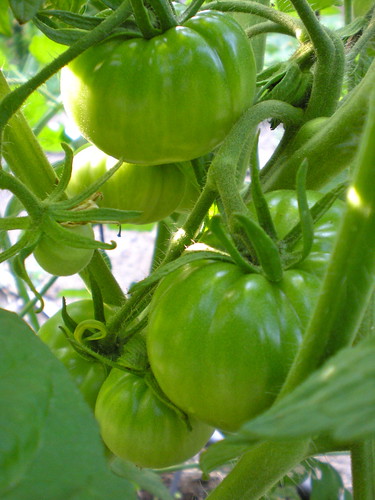 |
| zebra green |
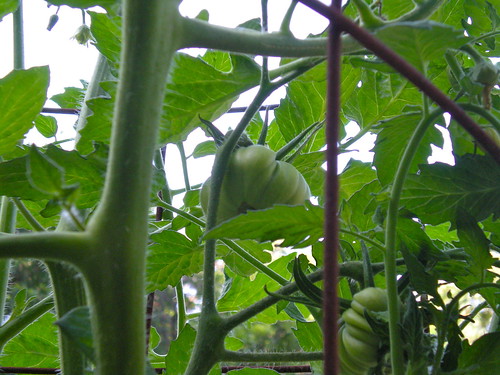 |
| aunt ruby's german green |
 |
| black krim |
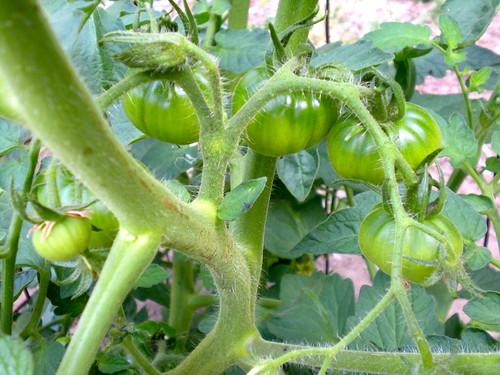 |
| beefsteak |
Edamame (soybean) is not an "economical" crop in terms of the space and time they take and the output they give. I insist on growing them every year because they are so much better than the frozen ones at stores. We never grow enough to freeze. Most of the time, we cook them right after they are picked.
These are butterbean edamame. They are grown from seeds we saved last year. We also sowed another variety, beer friend, in another bed. The germination rate for beer friend was really low (4 out of 21 seeds). The seeds were purchased from Kitazawa. All of the other seeds we purchased from Kitazawa germinated well, though. We re-sowed some more butterbean seeds instead.
Of course not everything is dainty and sweet in the garden. Meet the potatoes. They are sad looking and full of holes. Some of them are yellowing and dying. They didn't get enough water for a period of time and where they are doesn't get full sun. Perhaps these are the reasons they are not growing well. They don't look like they have blight.
Potatoes weren't part of the plan this year. We planted them because we had a bag of sprouted supermarket potatoes. The way I look at it is that any potatoes we get out of them are bonuses (or so I tell myself).
I won't make my "report" any lengthier. I'll try to show our other plants next time.
Wednesday, June 15, 2011
how's it growin'? (mid-june 2011 part 1)
I have been bad this season. Last spring/summer season I took pictures of the plants every week as a journal to note their progresses. This season I haven't been doing so. I also haven't done any "garden update" posts. I was going to do one about a month ago when my dad asked me how the garden was doing. I took some pictures, but never sat down to write a post. Oh well, better late than never.
So, here are some of the plants (pictures were taken last week)...
First up are the cukes. These are hybrid Japanese cucumbers (tasty queen 10). They are supposedly extra early and high yielding. I don't know about extra early, but it does look like they will produce well. I picked my first cucumber on Saturday, then four more on Monday.
They are not great climbers though. As you can see, we are trying to train them up the trellis/arbor. The idea is for them to climb up using the (neon pink!) strings. On the top, there are criss-crossed bamboo sticks and wooden bars so they can climb and grow across the beds. The arbor they create will provide shades for the veggies growing under it on those hot summer days. The arbor will cover 2 beds. The edible luffa gourds and bitter melons in the next two beds will climb up the same arbor.
Here's a picture of that first cucumber. It was harvested after this picture was taken.
These are the greens growing in the same bed with the cucumbers. There are spinach, red and green salad bowl lettuces, tung ho (edible chrysanthemum), a-choy lettuces, and New Zealand spinach (you can't see them as they are still small). I sowed these greens and the brassicas in the next bed really late (a little more than a month ago). I'm sure glad I did. The weather's been cool and they are loving it.
The edible luffa gourds are growing slowly. It enjoys hot weather, so it's one of the veggies that's not happy about the cooler temperature.
These are some of the brassicas growing in the same bed with the luffa gourds (mizuna, southern giant curled India mustard, summerfest komatsuna).
Here are our pole beans (Kentucky Wonder, frosty lima, yard long). Kentucky Wonder is the healthiest of the bunch at the moment. Frosty lima is still recovering from the slug attack earlier. Yard long seems to be the choice for the aphids. The yard long beans on the north side (righthand side of the picture) of the bed are infested with aphids. Last week I wiped aphids off the stems and cut off some heavily infested leaves and tips. We'll see if they recover and produce beans. I did see some ladybugs having feasts. I hope they'll bring over some family and friends.
I prefer our "V" shaped trellis over the "A" shaped trellis. It makes harvesting much easier. We built an "A" shaped trellis two years ago. I had a really hard time picking beans.
This is one of our nightshade beds (we have 6). The five plants you see in this picture were purchased. We did start some peppers and eggplants from seeds, but they were growing wayyyyyyy too slowly, so we had to buy most of our eggplants and pepper plants. The sun gold cherry tomato in the front was the only purchased tomato plant this year. All of our other tomato plants were started from seeds. This one is a bit behind the other tomatoes.
So, here are some of the plants (pictures were taken last week)...
First up are the cukes. These are hybrid Japanese cucumbers (tasty queen 10). They are supposedly extra early and high yielding. I don't know about extra early, but it does look like they will produce well. I picked my first cucumber on Saturday, then four more on Monday.
They are not great climbers though. As you can see, we are trying to train them up the trellis/arbor. The idea is for them to climb up using the (neon pink!) strings. On the top, there are criss-crossed bamboo sticks and wooden bars so they can climb and grow across the beds. The arbor they create will provide shades for the veggies growing under it on those hot summer days. The arbor will cover 2 beds. The edible luffa gourds and bitter melons in the next two beds will climb up the same arbor.
Here's a picture of that first cucumber. It was harvested after this picture was taken.
These are the greens growing in the same bed with the cucumbers. There are spinach, red and green salad bowl lettuces, tung ho (edible chrysanthemum), a-choy lettuces, and New Zealand spinach (you can't see them as they are still small). I sowed these greens and the brassicas in the next bed really late (a little more than a month ago). I'm sure glad I did. The weather's been cool and they are loving it.
The edible luffa gourds are growing slowly. It enjoys hot weather, so it's one of the veggies that's not happy about the cooler temperature.
These are some of the brassicas growing in the same bed with the luffa gourds (mizuna, southern giant curled India mustard, summerfest komatsuna).
Here are our pole beans (Kentucky Wonder, frosty lima, yard long). Kentucky Wonder is the healthiest of the bunch at the moment. Frosty lima is still recovering from the slug attack earlier. Yard long seems to be the choice for the aphids. The yard long beans on the north side (righthand side of the picture) of the bed are infested with aphids. Last week I wiped aphids off the stems and cut off some heavily infested leaves and tips. We'll see if they recover and produce beans. I did see some ladybugs having feasts. I hope they'll bring over some family and friends.
I prefer our "V" shaped trellis over the "A" shaped trellis. It makes harvesting much easier. We built an "A" shaped trellis two years ago. I had a really hard time picking beans.
This is one of our nightshade beds (we have 6). The five plants you see in this picture were purchased. We did start some peppers and eggplants from seeds, but they were growing wayyyyyyy too slowly, so we had to buy most of our eggplants and pepper plants. The sun gold cherry tomato in the front was the only purchased tomato plant this year. All of our other tomato plants were started from seeds. This one is a bit behind the other tomatoes.
There are a few flowers on the eggplants. I hope I'll see some baby eggplants soon!
Sunday, April 17, 2011
transplanting tomatoes and chayote
On Wednesday, I transplanted three of our tallest tomato plants. In a big tub, I mixed in some compost, bone meal, blood meal, worm casting chicken manure, a little bit of kelp meal, greensand, and dolomite lime.
After I loosened up the soil and dug three big holes, the compost mixture went into the holes with a handful of crushed eggshells sprinkled on top. Some soil was mixed in to reach the depth I wanted.
Then, I snipped off the lower branches and planted the tomatoes deeply. The tomatoes look really happy in their permanent spots (for the season). The rest of our tomatoes are getting really big in their 4-inch pots. I need to transplant them soon.
I also planted a chayote squash. Chayote is a tender perennial in tropical or subtropical area, so it should survive the winter in our climate. It's grown as an annual in cooler climates. I like chayote squashes, but I LOVE their vines. I always look for them when I go to the farmer's market. Young shoots and leaves simply sautéed with garlic tastes fantastic.
I bought the chayote squash on the left about 2 months ago. I kept it by the kitchen window and it sprouted. The vine was about 3 inches by the time I planted it. I later purchased the one on the right (about 1 month ago). It's showing sign of sprouting. I guess I'll have to wait a little before I can plant it out.
This is our first time growing chayote. I did some research. Some said to bury the whole squash leaving only the tip of the sprout above the ground and some said to plant it at an angle with the fat side down so that the stem end is just at the soil level. I decided to follow the second method.
After I loosened up the soil and dug three big holes, the compost mixture went into the holes with a handful of crushed eggshells sprinkled on top. Some soil was mixed in to reach the depth I wanted.
Then, I snipped off the lower branches and planted the tomatoes deeply. The tomatoes look really happy in their permanent spots (for the season). The rest of our tomatoes are getting really big in their 4-inch pots. I need to transplant them soon.
I also planted a chayote squash. Chayote is a tender perennial in tropical or subtropical area, so it should survive the winter in our climate. It's grown as an annual in cooler climates. I like chayote squashes, but I LOVE their vines. I always look for them when I go to the farmer's market. Young shoots and leaves simply sautéed with garlic tastes fantastic.
I bought the chayote squash on the left about 2 months ago. I kept it by the kitchen window and it sprouted. The vine was about 3 inches by the time I planted it. I later purchased the one on the right (about 1 month ago). It's showing sign of sprouting. I guess I'll have to wait a little before I can plant it out.
This is our first time growing chayote. I did some research. Some said to bury the whole squash leaving only the tip of the sprout above the ground and some said to plant it at an angle with the fat side down so that the stem end is just at the soil level. I decided to follow the second method.
Subscribe to:
Posts (Atom)




















